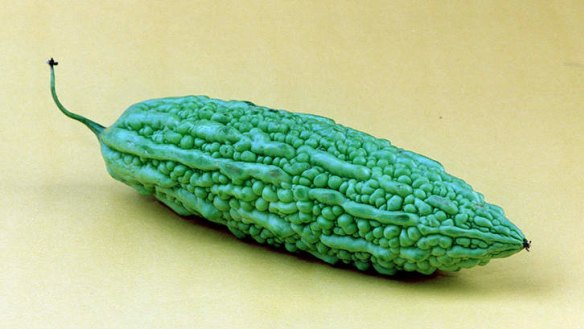Five of a kind: Asian vegetables
Asian vegetables come in many shapes and sizes, with tastes ranging from bitter to sweet and textures from soft to crunchy.

Bitter melon
''Attractively warty'' is how Charmaine Solomon describes the bitter melon. It's a traditional Asian cure-all and has been proven to have blood sugar-lowering properties. Its health benefits don't come without a cost, though - this cool cousin of the cucumber is intensely bitter. A good introduction is to add it to scrambled eggs. Cut the melon lengthwise, scoop out the seeds and pith and slice into thin crescents. Cover with salt, as you would eggplant, before leaving for five minutes and rinsing. Toss in the pan with some oil and garlic, then scramble in some eggs.
Water spinach
This nutritious green vegetable grows prolifically in moist or swampy areas across Asia. It has hollow stems and pointed leaves not unlike those of Vietnamese mint. Look for it in bunches at Asian grocers. The flavour is similar to spinach, but while Popeye's favourite is wont to turn to mush under pressure, the textural contrast of cooked leaves and stems is most enticing. A pile of lightly cooked kangkung makes a delicious side dish. Wash the leaves well, cut off tough or woody lower ends and break into bite-sized lengths. Add oil and garlic to a blisteringly hot wok, toss in water spinach and sprinkle with a little fish sauce and white sugar.
Chrysanthemum leaves
In the west, chrysanthemums are known for their pretty, ruffled flowers, but in Asia they are most beloved for their leaves. The shape differs between varieties, with some leaves feathery and others more serrated. Use them as you would spinach, cooking for just a few minutes; they have a herbal, grassy flavour. Look for specimens that are not wilted or yellowed. If the stems are tough, pick off and use only the leaves. The Japanese blanch the leaves, refresh them in iced water and dress with a simple sesame dressing made with roasted and pounded sesame seeds mixed with a little soy sauce and sugar.
Taro
Taro could be described as the Asian potato - starchy, neutral and versatile. In China, it is cubed, fried and dipped in hot toffee. In Japan pieces are simmered in gentle braises. It has a slightly gummy texture and a nutty flavour. The tubers look like huge flower bulbs. To prepare, peel taro deeply; wear gloves as the juice can irritate the skin. Try tossing chunks in curries or soups in place of potato. Taro stems are also edible and are for sale in Asian markets. These long green spears have a spongy, honeycomb-like texture, but must be carefully prepared to disgorge them of their high levels of oxalate.
Jicama
Also known as yam bean, these large, bulb-like vegetables are the root of a vine native to Mexico. Transported by the Spanish from Mexico to the Philippines and hence the rest of Asia, jicama is cool, crunchy, moist and slightly sweet, and has been compared to a water chestnut or a pear. Look for medium-sized, firm specimens. Uncut, they will keep in the crisper for weeks. To prepare, peel and cut into matchsticks or small cubes. Jicama adds crunch to any salad - try adding matchsticks to coleslaw, or create a Mexican-style side with cubed jicama, diced capsicum, avocado, coriander and a little lime and orange juice.
The best recipes from Australia's leading chefs straight to your inbox.
Sign up